#when I was a kid we got a few blizzards and would build tunnels through the snow
Text
Its Christmas weekend. Its December 24th. Its Christmas EVE. But you know what else it is?? Do you?
ITS FUCKING SPRING OUTSIDE IS WHAT IT IS
ITs gonna be nearly 60F outside on Christmas day. No snow. Stores have been selling sweaters since SEPTEMBER but WHY?? We dont need that shit until January anymore. We can survive the couple random cold days with a hoodie until winter actually kicks in. Yeah Im dreaming of a white Christmas just like the ones I used to know CAUSE THEY ARE PRACTICALLY NON EXISTENT NOW. Did you want to go sledding or have a snowball fight or build a snowman over your winter break? WELL TOO BAD FOR YOU. Instead you get rain this week.
And its not like I live in a warm climate either!!!! Im in Pennsylvania!!! In the foothills of the Appalachian MOUNTAINS!!!!!!! ITS SUPPOSED TO BE COLD HERE!!!!!!!
#screaming.to.the.gods#sorry just wanted to scream about it#when I was a kid we got a few blizzards and would build tunnels through the snow#winter break *felt* like winter#even if we only had a dusting of snow - it was at least freezing cold#it made you want to sit by the heater with hot chocolate#but now#Im walking around in shorts and a t shirt#its just absurd#christmas
638 notes
·
View notes
Text
Long Trail to McMurdo, Part 5: Getting There

At 5.45 on the morning of November 13th, I hauled my newly repacked luggage to the Antarctic passenger terminal to check in. Once ticked off the list, I had to find my two orange ECW bags from the other day and put on the parka, overalls, and bunny boots which were required to be worn on the flight. The rest of my stuff was sorted into four categories:
Carry-on – the items to keep with you at your seat on the plane. These can come in as many pieces as you want, but they all have to fit at once in a prescribed volume, measured by a plywood box at the CDC. Anything that doesn't fit in that box has to be checked.
Checked – Just like on a commercial flight, checked luggage gets stowed with the cargo and you are reunited with it at your destination. Unlike a commercial flight, even if your flight is cancelled or turned around in midair, you still won't see it until you arrive in Antarctica, because one it's been palletized it's a right old pain to get it out again. This is why you have a . . .
Boomerang Bag – Weather in Antarctica is extremely unpredictable, and as we have learned this year, aircraft maintenance can be, too. Sometimes you can be well on your way when a blizzard swoops onto the airfield and the flight has to turn around back to New Zealand. This is called a 'boomerang.' As your checked luggage will stay checked until you arrive in Antarctica, it is therefore wise to pack a few days' worth of clothes and toiletries in a separate bag which will be checked but not palletized, in case you end up with a prolonged holiday in Christchurch.
Leave in Chch – It's summer in New Zealand and also summer in Antarctica, but the former can be quite warm while the latter is well below freezing. Therefore there are probably clothes you won't be needing until you get back to New Zealand, and these are kept for you at the CDC until you return. I left my two skirts, a light cotton shirt, sandals, and antihistamine.
Once everyone was dressed and all our bags were appropriately tagged and checked, we were given our boarding passes and released to have breakfast at the strip mall around the corner. It was a rather quiet and rugged-looking bunch who poured into the trim café that morning; I wonder what the more casual visitors must have thought.
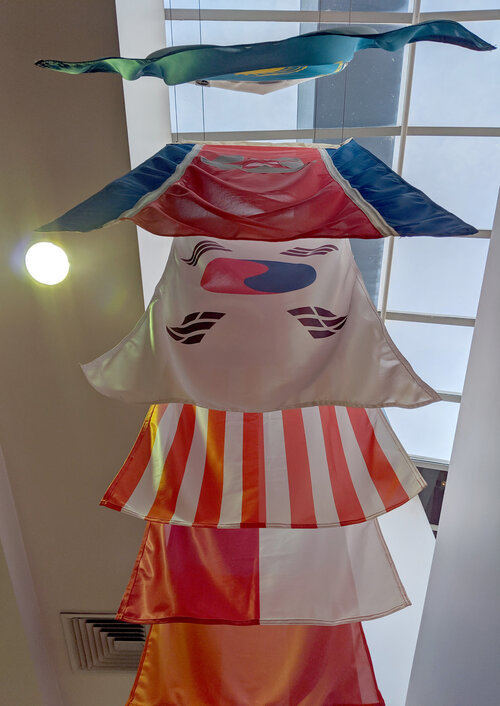
Then we were back to watch another video – I have seen so many of these now I forget what this one was about – probably the Antarctic Treaty, which is an agreement between all the nations that operate in Antarctica to preserve it for peaceful science and not to claim sovereignty over it. This makes it one of the few things that North and South Korea agree on.
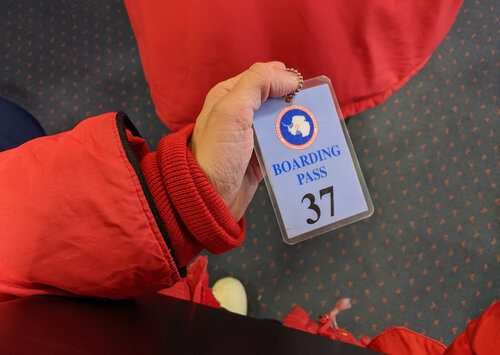
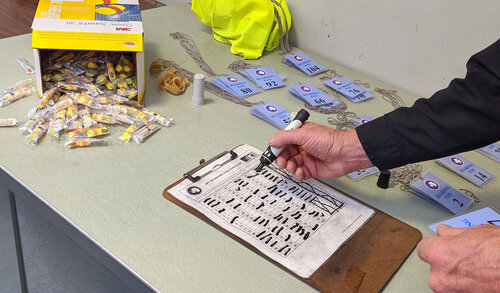
After the video, we queued for security, which was much like any security queue at any small airport, with the exception of the refreshingly low-tech boarding pass check. Once through the metal detectors and hand luggage scan, we boarded a school bus which was old enough I might have taken it on a field trip as a kid, to be taken out to the waiting C-17.

We passed the lame C-17 on the way to our shiny new Hawaiian one.

Had I been quicker into the queue, I might have got onto this very special private-hire city bus:

On the way into the plane we were each given a bagged lunch and some earplugs. The C-17 is not designed for passenger comfort, and we would be flown south in close proximity to four enormous jet engines. The hearing protection was appreciated.

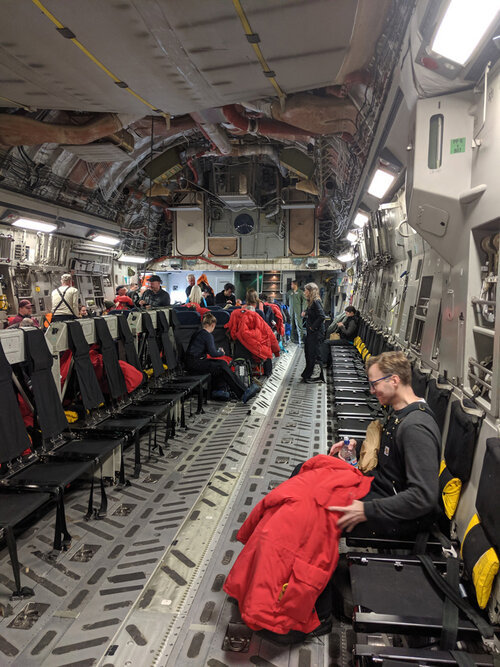
There were about ten rows of forward-facing seats in the plane, but I wanted the proper C-17 experience so I made my way to the line of lengthways seats behind them. We shared the fuselage with the cargo, and it became apparent why, once bags were checked, they weren't coming out again.


Just like on a commercial flight, we got the standard flight safety briefing, only our cabin crew were a pair of Guardsmen straight from central casting. Turns out, even on a C-17, the life vests are under the seats and are inflated by pulling on the toggle, but as there are no overhead lockers, the oxygen masks are in a compartment in the wall behind your head. Now you know.
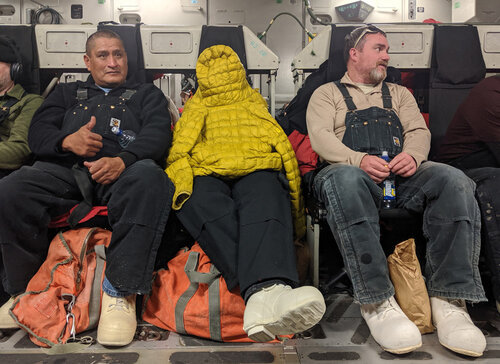
There were quite a few first timers on my flight, but it was obvious who the experienced polar travellers were, because they knew the most comfortable way to get some shuteye and got right to it. More sleepless ones had books or e-readers. The man next to me was reading quite an interesting history of the leadup to WWI from a naval perspective, but the book that most caught my interest (by which I mean, it made me laugh out loud when I saw the title) was a few seats up from me.

It was a strange thing to take off on a plane with no windows. We evidently turned a few corners, and we seemed to taxi the entire length of the runway before turning around to take off, but when they hit the gas, WOW did we ever go!
I had noble intentions of polishing off a good chunk of Worst Journey during the five-hour trip down, but the suspense of the last few days and the early morning soon caught up with me, and I joined the sleepers instead. When I woke up, I noticed a cluster of people around the porthole aft of my seat. Had we reached Antarctica?
YES.

Not long after this, we got the announcement that we were beginning our descent, so it was back to seats and on with ECW and seatbelts. For such an enormous bird, the landing was admirably smooth, and once all post-landing checks had been completed, the hatch was opened. Long before we felt the cold, we could see our breath in the air, as the moisture levels in the cabin met the declining temperature. I had read about how stepping off the plane was like walking into a wall of cold, so I'd put on my balaclava and goggles, but when my turn came to start down the gangway, I realised it was actually quite mild. Not what one would expect for being . . .
IN ANTARCTICA!
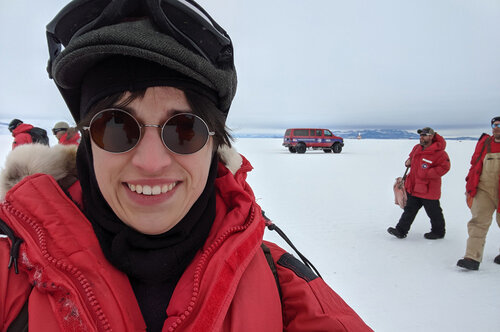
A low ceiling of cloud obscured the tops of the mountains, but all the same I had much the same experience as I had when I first came out of the tunnel into Lyttelton, as suddenly all my reading and reference photos slammed into place. There was Observation Hill, and up along the Hut Point Peninsula a surprisingly large square promontory – that's why they call it Castle Rock! Windless Bight, White Island (it's white!) and Black Island (it's black!) and though I couldn't see its stripey dome, what was obviously the foot of Mt Discovery. And my feet, standing on the snow of the Barrier! I barely had time to be surprised how close everything was before our gaggle of shuffling scarlet penguins was ushered onto an enormous red people mover and we started our ride to McMurdo.

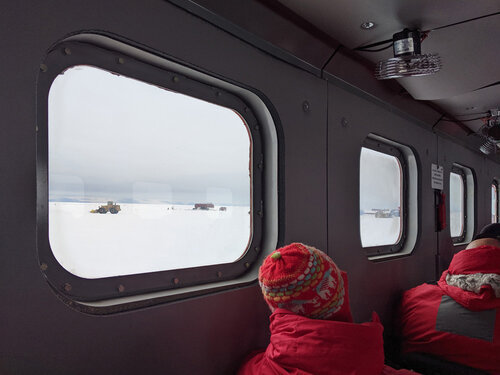
The windows were above eye level but if I stretched up I could see out. It turned out this was not a an effective strategy, as within a few minutes they had fogged up and I could only see through a narrow strip at the bottom. That may have been the more exciting way to come in to town, as the teasing glimpses of turquoise pressure ridges and the piebald slopes of the Gap suggested more than they revealed.
We pulled up outside big blue Building 155, the hub of activity in McMurdo, and as I stepped out into the light flurry of snow, there was Observation Hill with the Polar Party's memorial cross positively looming over everything. My coordinator, who had worked tirelessly all through the summer to line up resources for my visit and calm me down every time there was a hiccup with my medical, met me with an enormous hug, and I had a little cry on her shoulder. Here I was at last.

#mcmurdo#mcmurdo station#antarctica#united states antarctic program#usap#c-17#airplanes#aerospace#kress#travel
59 notes
·
View notes
Text
From Manchester City to Oklahoma: how a rejected footballer kept the dream alive
Laurie Bell became one of the most expensive 12-year-olds in British football history when Manchester City signed him from Stockport County, but he had to wait a decade and move 4,000 miles away to make his professional debut

In the dressing room of a baseball stadium in the American South, I fiddled with orange shinpad tape, yanked my heels to my buttocks to stretch already-limber quadricep muscles, and tap-danced impatiently on plastic studded football boots. Ten more debutants in creaseless kits waited in line. A dipping Oklahoma sun peeked inside the tunnel, beckoning. When the referees eventually signalled that it was time, we marched out. First on red clay, then green grass, then across the straight white lines of a freshly painted football pitch. In the stands, 8,000 soccer rookies rose to their feet, waved homemade flags, and glugged half-price cans of Modelo beer. Up in the posh seats, the clubs hierarchy were given a first tangible taste of a team that had been two years in the making.
It was a momentous walk for all of us: the first action on the first night in Tulsa Roughnecks history. For me, it proved the last, improbable leg of a 14-year journey that had transported me 4,000 miles from my English home. At 22 years old, after a sequence of rejection and lateral footballing progress, my professional debut had finally arrived.
Men in military uniforms trumpeted out a national anthem. For a moment, a reverential hush cloaked the excitement for soccer pulsing through this old oil city. Stood by the halfway line where short stops might field on baseball-playing days I considered how we all arrived here. How had this brand new team leapt into existence? What did this crowd expect? Was our flung-together squad any good? Whats that centre-backs name again? And, of all the football clubs in all the world, how the hell had I ended up in Tulsa, Oklahoma?
This wasnt English football. This hadnt been the plan.
Tulsa Roughnecks players sign autographs for their fans. Photograph: Lori Scholl
Statistically speaking, the first match in the Roughnecks record books ended in a 1-1 draw. But as sunburned schoolteachers and hoarse local lawyers joined kids clamouring for autographs at the perimeter of the field, that balmy night in March 2015 felt decidedly like a victory. Shirts sold, fireworks crackled and fans fell in love. Giddily unpracticed, I signed programs, iPhone cases and exposed forearms. Opening night was a win for the Roughnecks and for football in the city.
There was immediate evidence of both a passion and market for soccer in Tulsa, like there is in increasing numbers of cities across North America. In the past two seasons across the top three leagues covering the US and Canada the MLS, NASL and USL 24 new professional soccer clubs have founded. Tulsa Roughnecks is one part of professional soccers recent proliferation in the US. This is one players insight into life at a brand new club.
Describing Tulsa Roughnecks FC as brand new is only partly true. In 1983 a professional outdoor team from Tulsa named the Roughnecks was crowned king of the North American Soccer League. They beat the Toronto Blizzard in Soccer Bowl 83 in front of 53,000 fans.
The glitzy NASL attracted footballing greats such as Johan Cruyff, George Best, Pel and Franz Beckenbaur. Their presence helped draw impressive attendances at stadiums nationwide, with thousands more fans tuning in on TV. Even without a bona fide superstar, the Roughnecks enjoyed a strong local following and considerable onfield success. But when the league folded and soccers grip on the imaginations of the American people loosened, the team followed suit.
Having been founded in 1978, the Roughnecks disbanded six years later, the season after they won the championship. A few upstarts tried to bring the sport back to the city but they were unsuccessful and Tulsa was largely soccer-less for the next three decades until 2013, when Mike Melega, General Manager of the Tulsa Drillers baseball franchise, picked up his newspaper.
I saw in the paper one day that Oklahoma City was getting professional soccer, said Melega, the picture of an American sports executive: khaki trousers below a club-crested polo shirt and dark brown hair cropped neatly around the back and sides. At the time time, Melegas only title was GM of the Drillers, a feeder club affiliated with a Major League Baseball team, but his staff was also tasked with managing the Drillers under-utilised ONEOK Field, a three-year-old, $40m stadium in the heart of downtown Tulsa.
Youre always keeping your eyes open for trends and opportunities, continued Melega. Professional soccer in America is growing and I thought our city needs to be at the forefront of that.
Tulsa and the state capital, Oklahoma City, are 100 miles apart: neighbours by American standards. Melega discovered that the same ownership group had already purchased expansion rights for soccer teams in both cities. An attractive new sports franchise and a lonely stadium: the GM foresaw a marriage. Melega, along with Brian Carroll, vice president of media and PR, convinced the Drillers owners brothers Jeff and Dale Hubbard to fund a wedding.
Dale Hubbard is a former professional baseball player who had never watched a game of soccer. But Melega is persuasive and, trusting his judgment, the Hubbards purchased a majority share in their citys expansion rights. A crazy, crazy year and a half of preparations followed. But on 18 December 2013, addressing a room of reporters and early self-declared supporters, Melega held a scarf above his head and announced that soccer was returning to Tulsa. In 2015, the team would compete in the United Soccer League, the third tier of US soccer.
Laurie Bell playing for Tulsa Roughnecks. Photograph: Lori Scholl
That same afternoon in Milwaukee, Wisconsin I completed a Media Law exam. I was 21 and two-and-a-half years into a university soccer scholarship. Five days earlier I had been named in college soccers team of the year (making this Mancunian an All-American), having enjoyed my finest season as a footballer. From central midfield I scored 13 goals, captaining my Division One team to league success, record home crowds and a coveted spot in the NCAA national tournament.
I finished the exam then packed a suitcase to return to my parents home in England for Christmas. On the flight, early visions of playing professionally in the US pushed law out of my mind. At the time, I couldnt point to Oklahoma on a map.
Every time I touch down at Manchester Airport, Im struck by the abundance of white rectangles painted on to patchwork grass fields below. There are football pitches everywhere. While the game gains popularity in the soccer-hungry landscape of 2016 America, there remains just one other professional team within 250 miles of Tulsa. By contrast, within 25 miles of the Manchester runway sit nine professional clubs, with almost double that number at semi-pro level. Before my 18th birthday, I had represented three of them.
I was scouted by Stockport Countys School of Excellence as an eight-year-old and excelled in their navy colours for the next four seasons, building up a reputation in the region. So when Manchester City offered me a spot in their world-renowned academy, a tribunal ruled that hefty compensation was to be paid to County, making me one of the most expensive 12-year-olds in British football history.
A lifelong City fan, I gladly committed my teenage years to the academys Platt Lane training complex, where prodigies progress and dreams come true. Every Tuesday and Wednesday I was excused from school and reported to the same fields and the same coaches that reared my City heroes: Shaun Wright-Phillips, Stephen Ireland, Micah Richards and Joey Barton. On Saturdays after my own matches I ball-boyed at the stadium. From pitch level, I watched Daniel Sturridge and Michael Johnson make Premier League debuts, convinced that one day Id be out there too.
But the fantasy of playing professionally for my boyhood club ended when I was 16, graduated from high school and deemed not fast enough to mix it with the latest crop of demi-stars scouted from across the globe.
Two years later, a second door to dreamland shut firmly in my face. I had completed a two-season youth team apprenticeship at Rochdale AFC, a club 108 years older than the current Roughnecks. Desperate to land contracts, my team-mates and I fought to impress The Gaffer by whatever means necessary. On the pitch, we scrapped to a Youth Alliance league title. Off it, we completed chores: filling wheelie-bin ice baths with freezing water, packing training equipment into The Gaffers Nissan Navara and obediently scrubbing the first teamers boots we wished to fill.
I regularly trained with the professionals, played alongside them in the reserves, and appeared in a first-team pre-season match. When I was named the clubs Youth Player of the Year in 2011, I became quietly confident about my chances. But money wasnt flowing through the grey, north Manchester town. And the first-team was stacked with experienced central midfielders. I just dont see you replacing them next season, rang The Gaffers crushing message in May 2011.
On the drive home I pulled into a Chadderton layby to call Dad. As the call connected, I turned off the wipers and watched raindrops slide slowly down the windscreen. How much of my cracking voice he made out Im not sure. But he got the message.
We knew this was a possibility, so just keep your head up, mate, he reassured me. Were going to find you a club. This is not the end. Another, maybe even a better, opportunity is going to come along for you.
It would do, not that I could see it then. I was 18 and after a decade on the English academy track thought I was finally nearing destination professional football. As it turned out, I was just setting sail on the scenic way around.
Team-mates found non-league teams and workaday employment. School friends packed for universities. My academics, which I had managed to successfully attain alongside football, earned offers from a number of prestigious British schools. But none interested me. I needed football. If not, adventure.
When the tears dried, I impressed at a showcase match in front of scouts from across the globe and was presented with an opportunity that ticked both boxes: Soccer! In America!
I agreed to play on a four-year football scholarship at the University of Wisconsin-Milwaukee that would cover tuition fees and provide help towards rent and textbooks.
My flight to Americas Midwest region connected at JFK. On approach to landing I looked down: baseball fields everywhere. I sneered, silently judging a sport I didnt understand, never imagining a few years later I would be playing on top of a matching red clay diamond.
By late 2014, Tulsas new club had fans, a crest and a name. A competition carried in Tulsa World, the local newspaper, allowed readers to decide what the franchise would be called. Future fans voted for a Roughnecks resurrection. The club assembled a supporters group The Roustabouts from the most enthusiastic responders to the newspaper poll and drew up diagrams of how to squeeze a football pitch on to a baseball field.
Mike Melegas vision was taking shape. The Drillers had erected a soccer club from nothing. All that remained missing was an entire squad of players and a head coach to scout then train them. But as the baseball staff believed: if you build it, they will come.

The Roustabouts show their support. Photograph: Lori Scholl
David Irving already knew Tulsa well when Melega first made contact. The 63-year-old Englishman had played for the NASL incarnation of the Roughnecks for a season in 1980, following a career scoring goals in the UK for Workington, Oldham Athletic and Everton. He also knew the USL, having coached in the league for 16 years. He led Wilmington Hammerheads to a title in 2003 and set Glenn Murray on a course to the Premier League in the process.
Irving was appointed in November 2014 and handed keys to a renovated locker room full of empty seats. The search for a squad took him and Tom Taylor, his assistant coach, across half the northern hemisphere.
For the first two months I was just travelling, trying to recruit players and set up combines and look for players, said Irving, Cumbrian tones still heavy despite a quarter-century living in America. That was my priority and everything else would just kind of fall into place. I started during Thanksgiving. I went to combines in Chicago, to Fort Lauderdale, San Diego, LA, Vegas, Orlando, all over. Tom was in Ireland, I couldnt make that one. So we went all over. Its a process, and it was challenging putting a team together for February of 2015 when we started pre-season.
On their travels, the pair realised they were recruiting for a much different USL than the league they had worked in before.
In 2015, 13 newly founded expansion teams competed in the USL. The inflated league rebranded and restructured into two conferences an east and a west instead of one. Another five clubs began USL play in 2016, making the new-look league 29 teams strong, with yet more committed to join in 2017.
The influx is a product of two factors: the demand for professional soccer in more cities across America and the leagues alliance with Major League Soccer in 2014. Twenty-one of the current 29 USL teams have MLS affiliations. The relationship allows players to be loaned between teams, imitating the Spanish model, in which La Liga clubs field second rosters in divisions below.
At its core then, this evolving league is a developmental one. Evidence is in the young squads the average age of the Roughnecks 2015 team was 23 and the five substitutes a coach can field per match. Players generally sign modest contracts (with housing usually included) lasting the duration of the seven-month season, after which theyre on their own financially. According to Irving, change is good for US soccer.
Obviously its great to have the MLS teams entering the league, he said. It brings the whole thing up to a new level. I think every team has a different philosophy, whether theyre going to use the USL for development or for senior players to get time, or a combination of both or for academy players. Whichever, the league is getting better.
Laurie Bell playing for the Tulsa Roughnecks. Photograph: Lori Scholl
Bigger and better: the USL is growing in a very American way. And with professional soccer proliferating across the nation, more opportunities are opening up for players. However, spots for non-US citizens remain limited to seven per team, driving competition high between foreigners chasing their American dreams. Last year, I realised mine in Oklahoma.
The week before Irvings official appointment, my college soccer career ended in a 1-0 loss on a bitter winter night at Cleveland State University. Rooted inside the frosty centre-circle, I looked out into the Ohio abyss and wondered where football might take me next.
My sights were set on Major League Soccer and weeks later I was invited to the MLS combine, an annual three-day showcase attended by head coaches from each team in the top US league. I spent the winter preparing: first, alone on frozen Wisconsin astroturf pitches as I finished my university semester, then in England with Blackburn Rovers first team. But while with Blackburn, I suffered a cruel recurrence of the patella tendonitis that had haunted me as a teenager. In January 2015, I arrived in Fort Lauderdale, Florida with a suitcase full of painkillers and doomed hopes for a miraculous recovery.
As a foreigner, I was already vying for one of a limited number of international MLS spots. That season, Frank Lampard, Steven Gerrard, David Villa and Andrea Pirlo would claim four of them. To land a contract, I needed to at least outshine my college-age competition. Instead, in front of American soccer royalty, I winced through three forgettable 45-minute appearances. On draft day, the MLS commissioner called 84 names. Laurie Bell wasnt one of them. Rejection stung afresh.
I returned to Milwaukee questioning. Why had no club ever taken a chance on me? Was something fundamental holding me back? How long could I continue failing at chasing a dream? And was there anywhere left to try?
Some of these USL expansion teams still need players for this season, offered my college coach Kris Kelderman. Theyre putting together whole rosters from nothing. What do you think?
Not knowing what to think, I landed in Tulsa in late February and reported for a pre-season trial. A pair of tornadoes during the week did little to reassure me I was in the right place.
If I had hesitations about the wilderness of this new USL, they evaporated upon walking into the Roughnecks upmarket ONEOK Field home. I found my name fixed to a locker in Premier League-class changing rooms, a kit printed with my chosen No4, and was given a comfortable flat to sleep in. I met a young group of players who were impatient to prove themselves and a staff that was building from the ground up. Immediately, I wanted in.
Irving was familiar with me through a recommendation from another English coach I had played under the previous summer. As long as you dont want too much fucking money, he said, half-smirking, fully serious, as I sat trembling in his underground office at the end of my trial, wed like you to join us here this season.
I squirted a response, agreeing to become the 11th signing in Tulsa Roughnecks history then floated back to my new apartment. With no Wi-Fi installed yet, I hurried a mile to the nearest Starbucks to Skype my parents. As the call boop-boop-booped into life, the clouds broke and an orange sun bounced through the windows. Two expectant faces 4,000 miles away squeezed together inside my phone screen.
They want me, I announced, as relief as much as joy plastered all our faces. Im going to be a Roughneck. In the most improbable location a baseball arena in tornado alley, USA I had finally found my first professional football home.
Upon signing for enough money to contentedly live on, but not too fucking much I became part of a unique squad. Given the clubs new status, no players had past experience in Tulsa, resulting in an utterly egalitarian dressing room. No captains, no cliques, no hierarchy. And initially, not much leadership, conversation or banter either. Far from the abusive pre-season initiation stories Id heard from English first year pros, I took a seat at my locker, one of 21 equal parts. In Tulsa, rookies might have pumped up the balls, but our own were left unharmed.

The Roustabouts. Photograph: Lori Scholl
Almost inevitably, this unfamiliarity resulted in a slow start to our season. But form steadily improved and, ultimately, playing for a brand new club proved much like playing for any other. We won as many games as we lost, the squad united through plane rides, card games and nights out on away trips to Arizona, Washington and California, and we put ourselves in contention for post-season playoff qualification. After winning our final fixture 2-0, the fate of our season hinged on Austin Aztex beating Seattle Sounders 2 our rivals for a playoff berth one week later.
When the game arrived, Melega, Irving and the rest of the organisations staff suggested we watch together. Over the course of the year, players had grown close to the creators of a club at which most of our contracts were close to complete. So, on a hot September night we gathered inside Empire Bar, where orange Roughnecks scarves entwined with more faded football memorabilia on the walls. We knew our chances of progress were slim and the whole night shimmered in end-of-term affection. One midfielder had landed after-season work at the pub and nipped behind the bar to pull me a pint. By kick-off time, a Twitter invitation lured hundreds of Roustabouts cramming through the doors.
So we watched together. The staff, who had turned a fanciful idea to fill a stadium into a real life football club. The fans: regular Tulsa townsfolk wholeheartedly embracing their new hobby. And the cluster of coaches and players parachuted into this baseball playing southern US city from all corners of the globe and tasked to get the football rolling.
We did, but there would be no fairytale finish to Tulsas first season in the USL. Seattle won 3-2 and the settled table ranked us seventh best in the Western conference. On paper then, several of the 24 North American expansion clubs were more successful than Tulsa in 2015.
But as nail-biting TV-watching evolved into a lively end of season party, there felt like plenty to celebrate for all involved in the Roughnecks organisation. League positions and trophies are important goals for a football club. But truer measures of success for a start-up sports team are surely its reception by a city and integration into local culture.
To my mind, that has been the Roughnecks chief success, one that makes the club a model for future expansion teams. Irving placed as much importance on us bonding with fans signing every autograph and sharing post-match drinks in local bars as any onfield tactics. Melegas staff appointed The Roustabouts de facto club ambassadors and organised the squads appearance at several community events.
The result was that a diverse ONEOK Field crowd produced the fifth highest average attendances in the league nationwide, a remarkable feat in the clubs first season. When jogging through downtown on cool down days, workers banged on office windows, kids hi-fived us, and pick-up truck drivers affectionately tooted horns. And one year on, now plying my trade in Sweden, I still receive regular well wishes from Tulsans via Twitter.
As the afterparty staggered to Legends the citys resiliently popular country dancing hall and players, coaches, club staff and supporters joined cowboy-booted locals on the dance floor, the assimilation felt complete. To sustain this professional soccer proliferation, each new North American club must dance to its own beat. And thats how I learned to Tulsa two-step.
This article appeared first on In Bed With Maradona
Follow Laurie Bell and In Bed With Maradona on Twitter
from All Of Beer http://allofbeer.com/from-manchester-city-to-oklahoma-how-a-rejected-footballer-kept-the-dream-alive/
0 notes